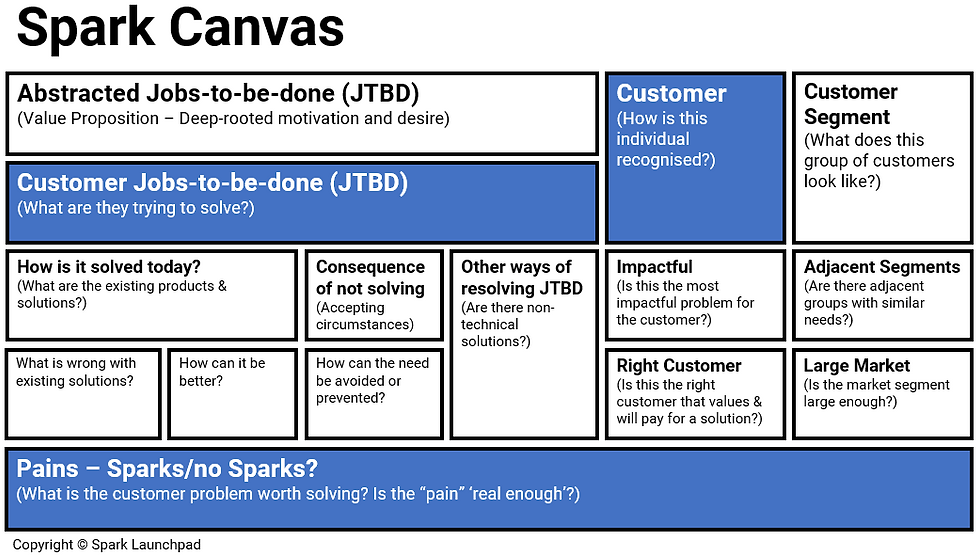Spark Canvas - Problems Worth Solving
- Patrick Ng
- Jul 24, 2022
- 3 min read
Updated: Nov 18, 2025
The BMC and VPC are not enough
Working with over 80 start-up teams in the past year made me realise that the Business Model Canvas (BMC) and Value Proposition Canvas (VPC) aren't enough. The Jobs-to-be-done section in the VPC is not emphasised enough, and ideas fail because of poor customer-problem fit. Most teams treat the VPC as a solution tool and less as an ideation tool.
How shall we get the start-up teams and ideators to focus more on the customer, identify direct and indirect competition, assess if the customer is willing to pay for a solution, and what features must the solution comprises.
We need a better Customer-Problem discovery framework

Figure: Spark Canvas - Problems worth Solving
Let's start by defining the customer and the problem. We define the customer as someone with a significant enough problem who will pay for a solution that solves this problem. Sometimes, a customer is not the end user who benefited from using the product.
Describe the customer
How is this individual recognised?
Describe the customer's problems, the jobs to be done, and the intentions
What problems are the customer trying to solve?
Let's find out more about the problem the customer faces.
How is it solved today?
What are the existing solutions?
What is wrong with it?
How can it be better?
What is the consequence of not solving the problem?
How can the need to solve be avoided or prevented?
What other ways of satisfying the intent?
Are there more obvious, non-technical solutions?
Is there a broader abstracted Jobs-to-be-done for this problem that the customer seeks to resolve?
Value proposition - the deep-rooted motivation and desire
Focusing back on the customer again.
Is this the most impactful problem to solve for the customer?
Is this the right customer that values and will pay for a solution?
The Customer Segment
What does this group of customers look like? How do we describe them?
Are there adjacent segments with similar needs (that can be included)?
Is this market segment large enough?
Now, do we have the real problem worth solving?
What is the specific pains or difficulty caused by this problem?
Will they pay to have these pains resolved?
Is the pain real enough that warrant your time and effort to resolve it?
The Spark Canvas - Problems worth Solving
A canvas of the customer Jobs-to-be-done is put together to guide and remind problem solvers of the essential aspects of the customer and their problems, which I call the Spark Canvas. The Spark Canvas is designed to guide innovators in identifying problems worth solving. Output from the Spark Canvas feeds into the VPC as the Customer Jobs-to-be-done and Customer Pains.

Figure: The Spark Canvas generate inputs to the Value Proposition Canvas.
A canvas layout is chosen because findings and assumptions in one column influence and affect neighbouring assumptions and findings.
Spark canvas is designed to guide innovators in discovering the customer problem worth solving. It helps enhance an average idea by:
Discovery meaningful areas to add value and offer more endearing value propositions
Expanding the target customer segment to include similar customer segments with similar needs
Identifying potential competition (direct and indirect) promoting a superior solution that is more competitive
Investors and stakeholders can also use Spark canvas to assess the attractiveness of a business idea. More applications and examples of Spark Canvas will be published later.
About the Author
Patrick Ng is an instructor and mentor for deep-tech venture building. The primary methodology used is the Lean Startup movement by Steve Blank, which has been pivotal and game-changing in helping entrepreneurs focus better on the customer and things that matter more for early-stage ventures.
Patrick Ng also consults for corporates and SMEs as a certified management consultant in innovation & IP, digital transformation and corporate strategy. He was formerly a Head of R&D in a multinational organisation, filed 12 patents as an inventor, and worked for several years in technology commercialisation. He holds a Master degree in Management in Technology and a Bachelor's degree in Electronics and Electrical Engineering.




Comments